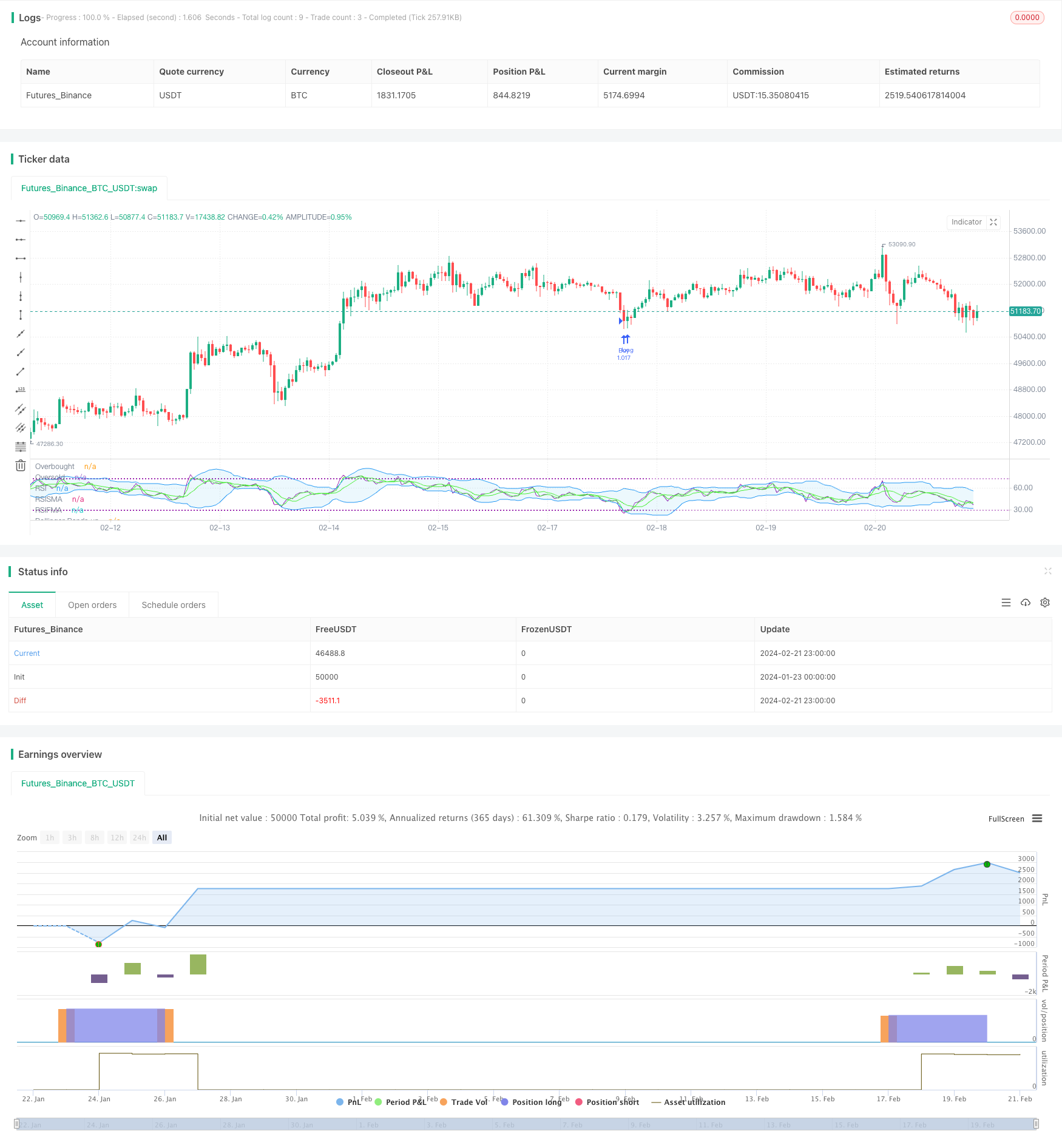
概述
RSI均线双金叉震荡策略是一种同时利用RSI指标与均线的金叉死叉信号来决定买入卖出的量化交易策略。该策略运用RSI指标判断市场是否被高估或低估,并结合均线的趋势判断,在RSI指标显示超买超卖现象的同时发出交易信号。这可以有效过滤假信号,提高策略的稳定性。
策略原理
该策略主要基于RSI指标与均线的组合使用。首先计算一定周期的RSI值,并设置超买超卖线。其次,计算快速均线及慢速均线。当RSI指标上穿上慢速均线,同时RSI值低于超卖线及下轨时产生买入信号;当RSI指标下穿下慢速均线,同时RSI值高于超买线及上轨时产生卖出信号。
优势分析
这种策略最大的优势就是同时利用RSI指标判断超买超卖现象,以及均线判断趋势方向,能有效避免假突破。此外,RSI与BOLL通道的组合运用也可以进一步过滤噪音,使交易信号更加准确。
风险分析
该策略可能存在的风险主要有:操作频率过高,容易迭仓;参数设置不当可能导致信号精确度降低。此外,震荡行情下也可能出现亏损。
优化方向
可以考虑调整RSI参数或均线周期参数以适应不同周期;结合其他指标过滤信号;设置止损止盈点以控制风险;优化每次交易的仓位管理。
总结
RSI均线双金叉震荡策略整体来说是一种较为稳定可靠的短线交易策略。通过参数调优与风险控制的配合,可以获得较好的收益回报率。该策略易于理解与实现,非常适合量化交易初学者学习与应用。
策略源码
/*backtest
start: 2024-01-23 00:00:00
end: 2024-02-22 00:00:00
period: 1h
basePeriod: 15m
exchanges: [{"eid":"Futures_Binance","currency":"BTC_USDT"}]
*/
//@version=5
strategy("RSI slowma Ismael", overlay=false, default_qty_type=strategy.percent_of_equity, default_qty_value=100)
// Definir la longitud del RSI
rsi_length = input(title='RSI Length', defval=14)
//media
Fast = input(title='Fast', defval=7)
slow = input(title='Slow', defval=2)
// Definir los niveles de sobrecompra y sobreventa del RSI
rsi_overbought = input(title='RSI Overbought Level', defval=72)
rsi_oversold = input(title='RSI Oversold Level', defval=29)
// Definir la longitud y la desviación estándar de las Bandas de Bollinger
bb_length = input(title="Bollinger Bands Length", defval=14)
bb_stddev = input(title="Bollinger Bands StdDev", defval=2)
// Calcular RSI
rsi_value = ta.rsi(close, rsi_length)
// Calcular Bandas de Bollinger
bb_upper = ta.sma(rsi_value, bb_length) + bb_stddev* ta.stdev(rsi_value, bb_length)
bb_lower = ta.sma(rsi_value, bb_length) - bb_stddev * ta.stdev(rsi_value, bb_length)
//media movil adelantada
fastMA = ta.sma(rsi_value, Fast)
slowMA = ta.sma(rsi_value, slow)
// Definir la señal de compra y venta
buy_signal = (ta.crossover(rsi_value, slowMA) and rsi_value < bb_lower and rsi_value < rsi_oversold) or (rsi_value < bb_lower and rsi_value < rsi_oversold)
sell_signal = (ta.crossunder(rsi_value, slowMA) and rsi_value > bb_upper and rsi_value > rsi_overbought) or (rsi_value > bb_upper and rsi_value > rsi_overbought)
// Configurar las condiciones de entrada y salida del mercado
if buy_signal
strategy.entry("Buy", strategy.long)
if sell_signal
strategy.close("Buy")
// Configurar el stop loss y el take profit
stop_loss = input.float(title='Stop Loss (%)', step=0.01, defval=3)
take_profit = input.float(title='Take Profit (%)', step=0.01, defval=8)
strategy.exit("Exit Long", "Buy", stop=close - close * stop_loss / 100, limit=close + close * take_profit / 100)
// Configurar la visualización del gráfico
plot(slowMA, title='RSISMA', color=color.rgb(75, 243, 33), linewidth=1)
plot(fastMA, title='RSIFMA', color=color.rgb(75, 243, 33), linewidth=1)
plot(rsi_value, title='RSI', color=color.purple, linewidth=1)
// Marcar las zonas de sobrecompra y sobreventa en el grafico del RSI
hl= hline(rsi_overbought, title='Overbought', color=color.purple, linestyle=hline.style_dotted, linewidth=1)
hll= hline(rsi_oversold, title='Oversold', color=color.purple, linestyle=hline.style_dotted, linewidth=1)
fill(hl,hll, color= color.new(color.purple, 91))
bbfill = plot(bb_upper, title='Bollinger Bands up', color=color.blue, linewidth=1)
bbfill1= plot(bb_lower, title='Bollinger Bands down', color=color.blue, linewidth=1)
fill(bbfill,bbfill1, color= color.new(#2bb5ec, 91))